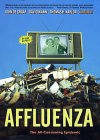Summary | Excerpt | Reviews | Readalikes | Genres & Themes | Author Bio

Critics' Opinion:
Readers' Opinion:
First Published:
Jun 2001, 275 pages
Paperback:
Aug 2002, 288 pages
"We said ‘if we build it, they will come,' and they did," gushed a happy shopkeeper. Another explained that its hardwood floors "add a little sense of excitement to the mall. They're much easier than walking on tile or granite and make the Super Mall really special." She hoped children would enjoy it, "because shopping has become such a family experience that's really important."
Really. And it's a good thing, too, since we Americans now spend six hours a week shopping and only forty minutes playing with our kids. "Shopping malls have really become the centers of many communities," says Michael Jacobson, founder of the Center for the Study of Commercialism in Washington D.C. "Children as well as adults see a shopping center as just the natural destination to fill a bored life."
WHAT ELSE MATTERS? "If you've seen the mall, you've seen them all," sneer critics like Jacobson, but "committed shoppers" (some psychologists say they should be committed) disagree. They're willing to jet across the country for new shopping experiences. So much so that some airlines now offer package flights to shopping Meccas like Potomac Mills, a giant "discount" mall divided into sections that are euphemistically labeled "neighborhoods." Potomac Mills bills itself as the "number one tourist attraction in Virginia," with more visitors each year than Shenandoah National Park, itself the most visited site in the National Park system.
The host of Affluenza, Scott Simon, visited Potomac Mills while filming the television program. Shoppers were eager to answer his questions about where they came from and what they thought of the mall. None of the people Simon talked to were sweating profusely. But all seemed infected by shopping fever, often the first symptom of affluenza.
Two women from Dallas, Texas, said they'd been at the mall for three days straight, while their husbands golfed nearby. "We're always looking for a bargain. You've got to know the brands and we have experience, we're proud to say," they proclaimed. "I didn't need anything. I just went to shop," said a man with a cart full of merchandise. "Whatever I like I buy." "I bought a lot more than I planned to," another woman admitted. "You just see so much."
Yes, you do, and that's the idea. It's why big malls sell much more per square foot than do their smaller counterparts. Seeing so much leads to impulse buying, the key to mall profitability. Only a quarter of mall shoppers actually come with a specific product in mind. The rest come just to shop. "What else matters?" asked one of the ladies from Dallas, only half in jest.
"I came here with one overriding interest, to spend money," said a proud teenage girl, who was getting rid of the hundred dollars her mother had given her for this particular spree. "I like to shop," she explained. She's not alone. One poll found that ninety-three percent of teenage American girls rate shopping as their favorite activity.
An older couple passed by with a shopping cart piled to the brim. "This is only half of what we've purchased," the man said cheerfully. "We brought a long list of things to buy," his wife added, "and then we bought a lot of stuff that wasn't on the list." Impulse. They were examining the fold-out map Potomac Mills provides to shoppers, saying, "we'd be lost without it."
But Potomac Mills is a mere mini-mall compared to the Mall of America in Bloomington, Minnesota. With 4.2 million feet of shopping space, our biggest mall ("Where It's Always 72 Degrees!") spreads over an area the size of seventy-eight football fields. It employs 10,000 people and attracts forty million visits a year. The Mall of America is more than metaphorically a cathedral; some people even get married there. It is also a world-class affluenza hot zone.
In the Age of Affluenza, nothing succeeds like excess. "Good malls are usually the most profitable kind of real estate there is," says one Los Angeles real estate consultant. "Good malls are money machines." "Good," he points out, means bigger. Because of that, the frenzy to attract megamalls pits city against city, each offering sweetheart deals in hopes of capturing tax revenues later on. To win such deals, mall developers compete for the most-profitable stores. According to The Sacramento Bee, the Seattle-based Nordstrom Company received $30 million in direct subsidies and incentives to put a store in Roseville, California's Galleria Mall. Why? "Nordstrom's does the highest sales per square foot in the industry," says mall developer Michael Levin. Most people, says Levin, will only drive about half an hour to a mall, "but with Nordstrom, they will drive much further."
From Affluenza: The All-Consuming Epidemic, by John De Graaf, et al. © June 9, 2001, Berrett-Koehler used by permission.





The Flower Sisters
by Michelle Collins Anderson
From the new Fannie Flagg of the Ozarks, a richly-woven story of family, forgiveness, and reinvention.

The House on Biscayne Bay
by Chanel Cleeton
As death stalks a gothic mansion in Miami, the lives of two women intertwine as the past and present collide.

The Funeral Cryer by Wenyan Lu
Debut novelist Wenyan Lu brings us this witty yet profound story about one woman's midlife reawakening in contemporary rural China.
Your guide toexceptional books
BookBrowse seeks out and recommends the best in contemporary fiction and nonfiction—books that not only engage and entertain but also deepen our understanding of ourselves and the world around us.